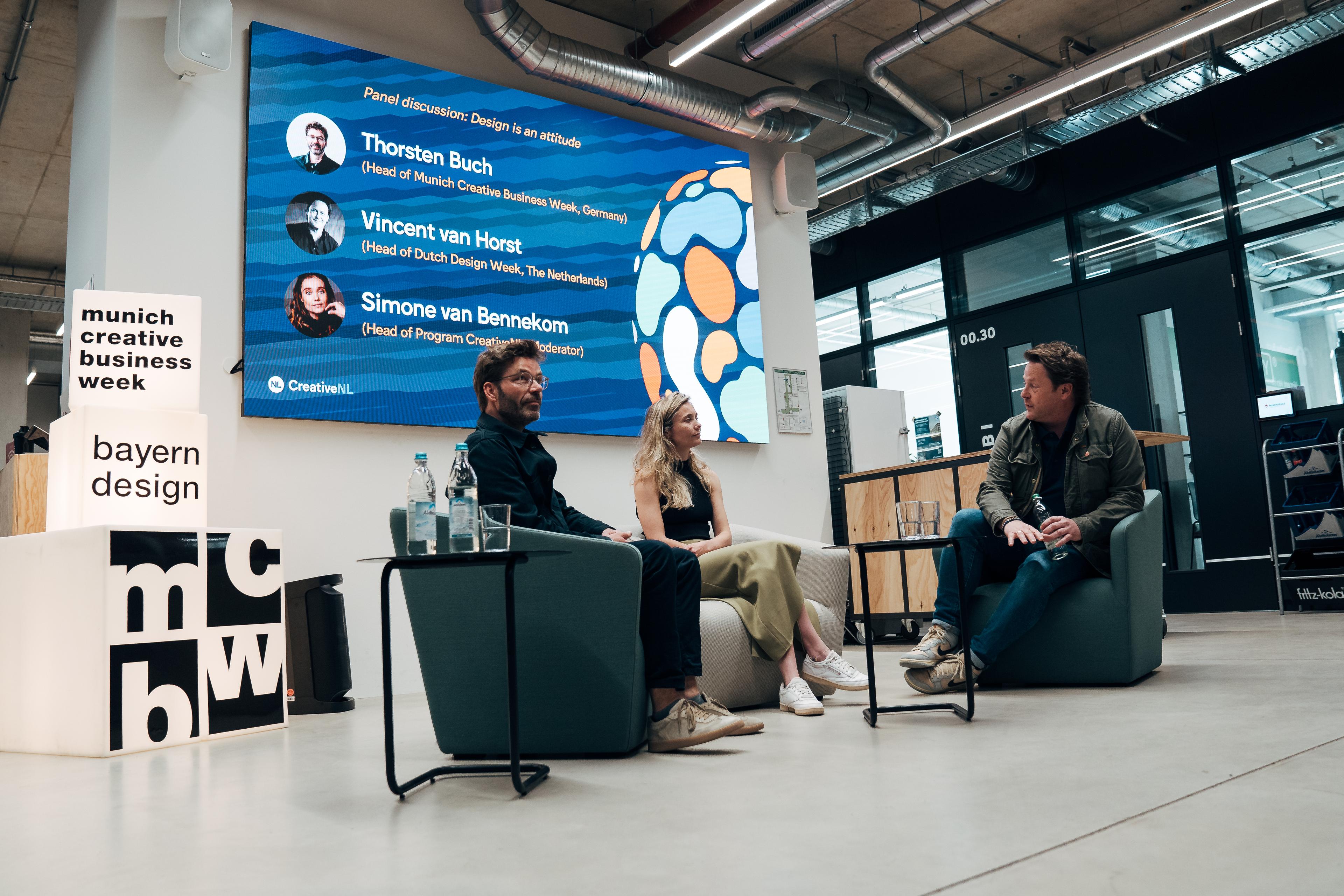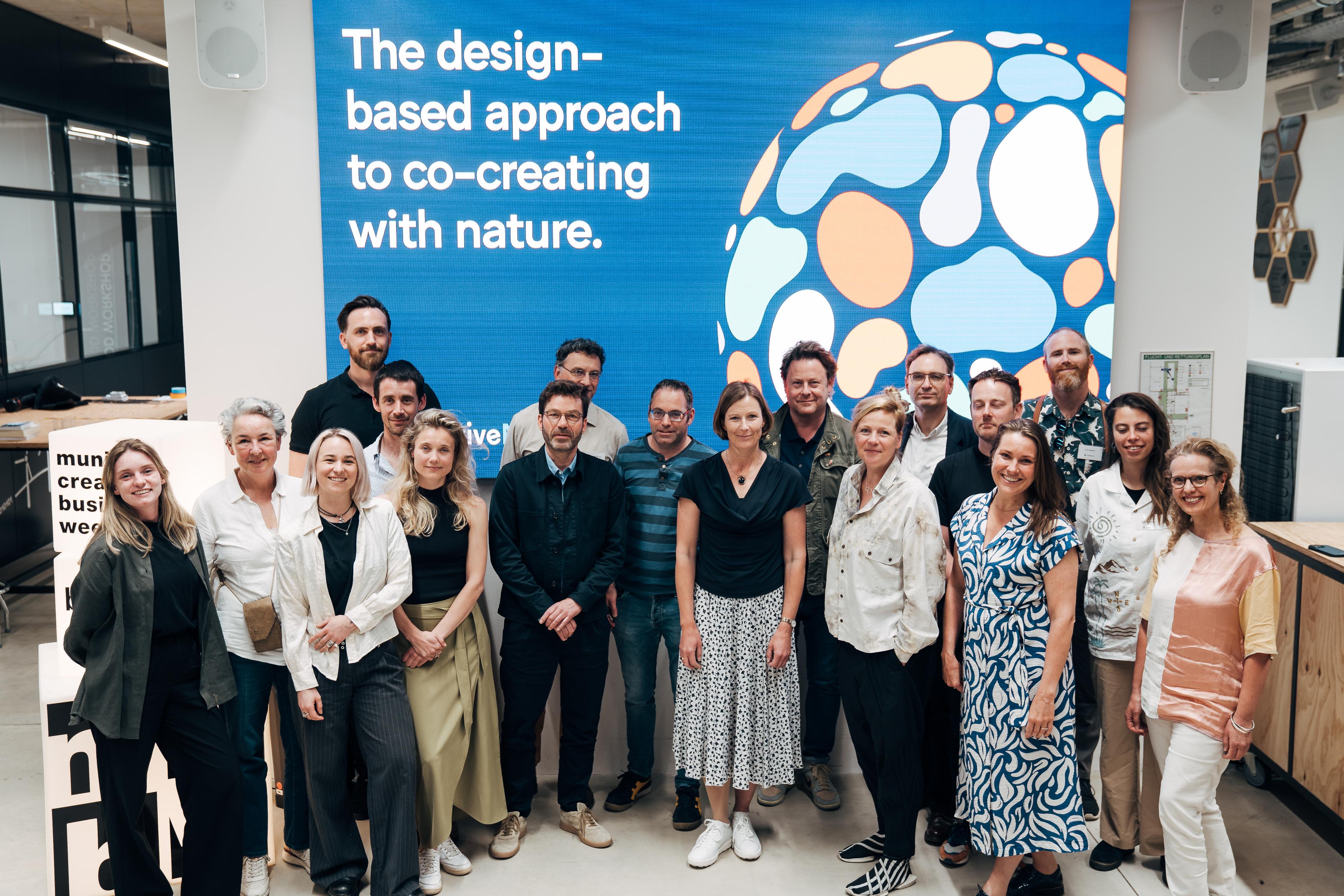CreativeNL in Munich: 'My ambition is to make as many people as possible aware of the power of design'
Creative x EnergyOne of the components of CreativeNL and Creative Arnhem's program during munich creative business week 2024 (MCBW) was the exclusive live conversation between Thorsten Buch and Vincent van Herk, the heads of MCBW and Dutch Design Week. Moderated by Simone van Bennekom (head of program CreativeNL and Creative Arnhem) they shared their views on the current design landscape, the differences between German and Dutch design, and the role of design in a society yearning for innovation.

The conversation wrapped up the program The design-based approach to co-create with nature of the Dutch creative industry/CreativeNL during MCBW, conducted by Creative Arnhem in collaboration with Design Platform Arnhem and Fashion Partners 025.
For a year now, Thorsten Buch has been Head of Munich creative business week (MCBW), Germany's largest design festival, which takes place every year in Munich - with over 200 events organized by around 190 partners. This year was the 13th edition.
Since 2022, Vincent van Herk has been Head of Dutch Design Week (DDW), Northern Europe's largest design event. During the nine-day event, Eindhoven is completely dedicated to design and covers all possible disciplines and aspects of design. DDW was first organized in 2001.
One of our participants, designer Rosalie Apituley, wondered why the word “business” was incorporated so emphatically into the name of the event, munich creative business week. Can you clarify that for us, Thorsten?
Thorsten Buch: “That's obviously done on purpose. We see design as something that touches everything. Indeed, it touches business in multiple ways. You can entice consumers with it, but also improve processes and directly influence behaviour with sometimes very simple interventions. MCBW fosters interdisciplinary dialog and brings together the public, experts, designers, company representatives, and students from design, architecture, the economy, and other disciplines to deliver comprehensive design experiences.”
Vincent van Herk adds: “That is the great thing about these kinds of events and exchanges; you learn from each other. In the German design community, that pragmatic approach is central. With us it's always about the future; about the future of the profession and about designing for the future. By far the most frequently used word in all publications about DDW last fall was ‘future’.
We won't easily emphasize the word business, but the common denominator by now is that we look at the future more pragmatically when it comes to design and innovation. And [that] the German community is now more forward-looking when it comes to innovation and all the social challenges that are out there.”
These types of events can be quite overwhelming. How do you ensure that participants and visitors have a good overview of what you have to offer and that your message is clearly communicated?
Van Herk: “Every year, we reflect with those directly involved: the designers themselves, visitors, and business and media partners. For example, last year, we chose five missions that visitors could follow: Thriving Planet, Living Environment, Health & Wellbeing, Equal Society, Digital Future. This year, we want to program those missions more concentrated on one or a few days, because we know that most (professional) visitors come for a maximum of two to three days. But it remains a challenge, I admit. Especially in a world where so much is happening at the same time and the key role design now plays in it.”
Buch: “I can only agree with the challenge. A theme works well for us because it provides focus. You can then highlight that theme from different perspectives, as you have done today: showing how your design approach to problems allows you to co-create beautifully with nature.
Our themes always have a social angle: Moving Horizons in 2022, Why disruption unleashes creativity in 2023, and this year How to co-create with nature.

What does design actually mean to you, what is your definition of it?
Buch: “There is no single definition as far as I am concerned. Design is the only field that touches on everything. It is about product and process. When you wake up, you are surrounded by design. Practically everything is designed. That, this perspective, has become common in the last ten years.
Design has gained more influence; on what I consume, on the street, and now also on how we want to design the future and can help innovation.
How I look at Dutch Design: the Netherlands has a wealth of typographic and graphic tradition. The signage (by Benno Wissing of Total Design, ed.) at Schiphol Airport, for example, was very progressive. You can see that elegant but functional way of designing now also in the design approach to social issues.”
Van Herk: “The concept of design is sometimes difficult to explain; many people think of a handbag or a chair. However, design is much more of a problem-solving mentality that 'answers' the question behind the question. So not: design this or that. But what problem do you solve with it?
The perspective has also changed, though. For example, you see a lot more social design coming up in the last few years. That human driven design mentality is refreshing, and you don't see it in many countries yet. How I look at German Design, Germany especially / indeed has a more businesslike product design tradition.”
With all the social challenges, how have your two platforms developed, can you name a milestone?
Buch: “I've only been here for one year, but what I've seen partly as a visitor is that corona has changed everything. There is so much more digital design, you can see that now with immersive design. Digital/digital transition now plays a much bigger role.”
Van Herk: “Before, design and what we presented was more tangible. Now take social design, which often includes much research, how do you show that? How do you visualize how you have transformed an entire neighborhood and in such a way that the public and policymakers want to engage and collaborate?
Because that's what designers want, too, in the Netherlands last fall, the Ministry of Education, Culture and Science launched a program called Public Design Practice (PONT) to increase the impact of a designing approach to social issues. Dutch Design Foundation is the executor in this for the coming 4 years. That recognition for designers that they can help in this regard is huge.”
What is also remarkable is that your event attracts not only the design community but also a wider audience. Why is design so lovable?
Buch: “We keep talking about product design, graphic design, social design and processes. But I think we should make it much wider: it's about creativity in a general sense. It's also about architecture and gaming, for example; that's all 'design' too. As I said, everyone interacts with design on a daily basis.
We want to be a platform for everyone, for designers, freelancers, agencies, large companies, students, consumers, and we don't charge an entrance fee for most of it, so the barrier is low.
Apart from that, you also have a program here. We know by now from the theme (how to co-create with nature, ed.) there are no boundaries; everything is connected. Exchange is therefore crucial; only then will we get further.”
Van Herk: “We had a senior official visit us last year, and he said, ‘It's so great to be here.’ There is a lot of negative sentiment in these days. Here you feel optimism, hope!' Because that is design, it is solution-oriented and focused on progress.”
Buch: “Design is always focused on making life easier or more simple, on providing accessibility - on positive emotions indeed.”
How do you want to further develop your platforms, what problems need to be solved in that context?
Van Herk: “People always talk about the number of visitors, but more important is the type of visitors. What I mean by that is that we focus on the entire community, the makers, the companies, governments, media, education and involved citizens. The network that's the most important thing. If that grows, you have a winner. That's the higher goal.
I also notice that when there is an exchange of perspectives, you feel that something gets going and something new emerges.”
Buch: “Being more visible, creating even more buzz in the city and region. The qualitative feedback is already excellent and the audience is engaged, which is great to see! My ambition is to make as many people as possible aware of the power of design. After all, many people don't know that yet.”
Van Herk: “Sometimes it is a challenge to get new developments across properly, then there is still a lack of budget (read: business partners). And we serve several stakeholders, so it is sometimes difficult to capture that in one campaign - because not everyone talks the same language. While communication is crucial for success!”
Finally, what is your personal motivation for this role? How did you get here?
Buch laughs, “I was asked. I have a background in Communication Design, Brand Design, On-air Design and Product Design and have always had a passion for how to communicate with design. For example, I designed experiences for car brands at trade shows for seven years.
Through a designer friend who loves output, chaos and unlimited creation, I found out that I like structure, good organization and simplicity; I like to reduce design to its essence.
I have never done career planning; I have always followed my gut feeling, my own ‘nature’. But I have always been open to learning new things and exploring areas; in that respect, especially in these times when there is much to discover, this role suits me very well.”
Van Herk: “My parents often said with a smile: you don't know what you want. Then I tried to draw, and then study economics. I went from left to right, from study to study. Until I finally ended up at a large format printing company developing interior prints; there, I learned the languages of business and creativity and their combination. At one point, I met two designers who were creating artwork with sunflowers for an eye department in the hospital because - sunflowers are the last thing that people going blind can still see a little bit. So I learned about the soft side of print and social design avant-la-lettre and found large print orders as such becoming less and less interesting.
To cut a long story short, in 2017, I founded Driven by Design, which was already harnessing the power of design for change. I then got in touch with the Dutch Design Foundation, the organisation behind Dutch Design Week. I've been on board since 2019, first in other roles, and the rest is history.
But as you've heard before, I - with DDW - prefer to look to the future. In which a whole lot needs to happen and in which, fortunately, design can play a wonderful, important part as an accelerator of change and innovation! I hope to meet you all in person 19-27 October at Dutch Design Week in Eindhoven ”

*) CreativeNL has been hosting events during MCBW for several years - since a “Letter of Intent” between the Munich and Amsterdam governments was signed in the fall of 2021; our participation has been building on that since then, this time in collaboration with Creative Arnhem.


